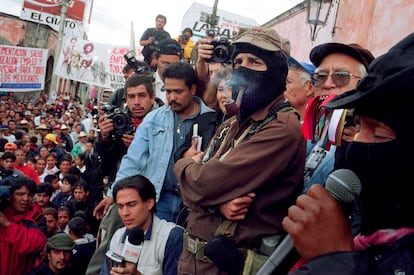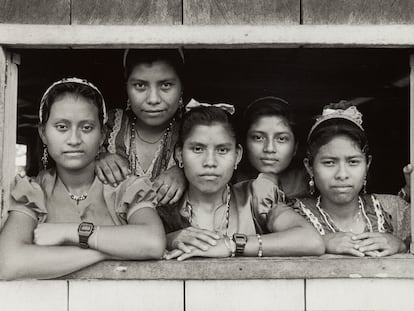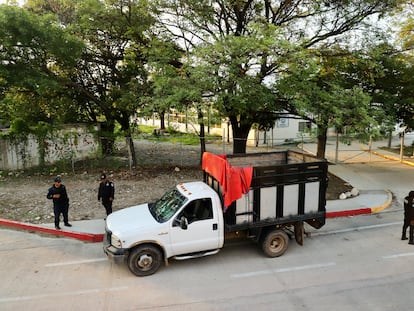Winds of change for the EZLN: The second death of Subcomandante Marcos
The Mexican guerrilla leader, who adopted the name Galeano in 2014, will step back to pave the way for a new generation


Subcomandante Marcos, the masked face of the Zapatista National Liberation Army (EZLN), has recently taken another step back in the movement he led for decades. The guerrilla commander, known for his eloquent speeches and political leadership, provided a voice for the Indigenous and marginalized people of Mexico who first took a stand against inequality on January 1, 1994. In 2014, Marcos withdrew from the Zapatista movement’s forefront, adopting the name Galeano in honor of a fallen comrade. He appointed Subcommander Moisés as his successor, signifying a generational shift within the organization. There was little doubt that his decision almost 10 years ago was primarily cosmetic — another calculated move by a crafty and theatrically inclined communicator. Now, a letter has formally announced the symbolic passing of Subcommander Galeano, a type of second death for the man the world once knew as Marcos.
“SupGaleano died. He died just as he lived: unhappy,” says the opening line of the letter posted on the EZLN website. His letter is infused with the acerbic, self-deprecating and somewhat perplexing style that has been a defining characteristic of Marcos’ writings since the 1990s. The letter is signed by “Captain Insurgent Marcos,” the new role of the former commander who has slowly stepped away from the forefront of the guerrilla organization. “Of course, he took care, before passing away, of returning the name to the one who is flesh and blood inherited from Master Galeano,” continues the letter. “He recommended keeping him alive, that is to say, fighting. So Galeano will continue walking in these mountains.”
The old Galeano died quietly, writes Marcos. “He started humming something like ‘I know I’m piantao, piantao, piantao,’ [crazy, crazy, crazy] and, just before he expired, he said, or rather asked: “Do dead people sneeze?” and that’s it. Those were his last words. No sentence for history, nor for a tombstone, nor for an anecdote told in front of a fire. Only that absurd, anachronistic, extemporaneous question: ‘Do the dead sneeze?’… We spared the funeral. Although we lost the opportunity for coffee and tamales.”
Generational changing of the guard
Marcos’ statement precedes two important milestones for the EZLN. November 17 will mark the 40th anniversary of the guerrilla group’s inception in 1983. January 1, 2024, will commemorate three decades since the armed uprising, when the group’s anti-globalization message paradoxically reached households all over the world. These two symbolically significant dates seem to suggest a generational changing of the guard is happening within the movement.
Speculation has been circulating for months about a potential power shift within the EZLN, and Marcos’ withdrawal supports this theory. The next generation that will lead and revitalize the movement are the children of the guerrillas who rose up in 1994, along with all the people raised in the secluded and marginalized Indigenous communities of Chiapas. Insiders predict that Zapatista women will assume positions of responsibility soon, drawing parallels with the Kurdish liberation movement, which shares ideological and organizational similarities with Zapatismo.
Some recent clues support this theory. After a period of inactivity and media silence, the Zapatista movement has perked up recently. In May, following an attack on one of its communities by a paramilitary group, the EZLN issued an ominous statement warning of the escalating violence in Chiapas. “Chiapas is on the verge of civil war with paramilitaries and hired killers from various cartels fighting for [control] of the territory against self-defense groups, with the active or passive complicity of the governments of [Chiapas Governor] Rutilio Escandón Cadenas and [Mexican President] Andrés Manuel López Obrador.” The EZLN statement is similar to one it made in September 2021 after two of its members were kidnapped. Following the release of its statement in May, EZLN supporters around the world organized demonstrations demanding a stop to the war in the region.
On October 22, the Enlace Zapatista website published Nicaraguan poet Rubén Darío’s Part One: The Motives of the Wolf (the announcement of the symbolic death of Subcomandante Marcos/Galeano is Part Two: Do the dead sneeze?). Written in 1913, Darío’s poem tells the fable of a hungry animal, despised and abused by the townspeople. Despite its attempts to approach humans, the wolf eventually retreats to the mountains to escape the hatred and violence. For Marcos, the fable is an allegory of the EZLN vis-à-vis the Mexican government. “That poem by Rubén Darío… [is] a response to someone who asked how to explain what is happening now in Chiapas, Mexico and the world,” wrote Marcos in Do dead people sneeze?
The philosopher who took to the mountains
Subcomandante Marcos, whose real name is Rafael Sebastián Guillén Vicente, was born in 1957. Despite being from Tamaulipas (northeastern Mexico), he led the Chiapas rebels for over two decades, according to a bio posted by the National Autonomous University of Mexico (UNAM). He studied philosophy at UNAM and received awards for his academic performance. Then he retreated to the mountains, took up arms and became the ideologist of the most iconic guerrilla movement in modern history. “The best Latin American writer of our time, unbounded and incisive, treads through the dense jungle with a balaclava over his face,” said French philosopher and journalist Régis Debray in 1995.
When he announced his first death in 2014, Marcos declared: “I will no longer be the voice through which the Zapatista National Liberation Army speaks.” He adopted the name Galeano as a tribute to José Luis Solís, a fallen Zapatista combatant, and handed over command to Subcommander Moisés (of the Tojolabal indigenous community in Chiapas). But people familiar with the organization saw the change in 2014 as mostly symbolic. Marcos/Galeano remained actively involved in the movement’s communications and decision-making. The world will wait and see what will follow his self-demotion to the rank of “Captain Insurgent,” and where the winds of change will blow this revolutionary movement that once aspired to change everything.
Sign up for our weekly newsletter to get more English-language news coverage from EL PAÍS USA Edition
Tu suscripción se está usando en otro dispositivo
¿Quieres añadir otro usuario a tu suscripción?
Si continúas leyendo en este dispositivo, no se podrá leer en el otro.
FlechaTu suscripción se está usando en otro dispositivo y solo puedes acceder a EL PAÍS desde un dispositivo a la vez.
Si quieres compartir tu cuenta, cambia tu suscripción a la modalidad Premium, así podrás añadir otro usuario. Cada uno accederá con su propia cuenta de email, lo que os permitirá personalizar vuestra experiencia en EL PAÍS.
¿Tienes una suscripción de empresa? Accede aquí para contratar más cuentas.
En el caso de no saber quién está usando tu cuenta, te recomendamos cambiar tu contraseña aquí.
Si decides continuar compartiendo tu cuenta, este mensaje se mostrará en tu dispositivo y en el de la otra persona que está usando tu cuenta de forma indefinida, afectando a tu experiencia de lectura. Puedes consultar aquí los términos y condiciones de la suscripción digital.
More information
Archived In
Últimas noticias
Rowan Atkinson tops Netflix at 70: ‘He’s as funny as ever’
Israeli recognition of Somaliland stirs up the Gulf
Tiger Woods turns 50: Will he continue playing on the PGA Tour or take a back seat?
The surreal journey of James Nnaji, the Barcelona youth player selected in the NBA Draft who ended up in the NCAA
Most viewed
- Oona Chaplin: ‘I told James Cameron that I was living in a treehouse and starting a permaculture project with a friend’
- Reinhard Genzel, Nobel laureate in physics: ‘One-minute videos will never give you the truth’
- Sinaloa Cartel war is taking its toll on Los Chapitos
- Why the price of coffee has skyrocketed: from Brazilian plantations to specialty coffee houses
- Chevy Chase, the beloved comedian who was a monster off camera: ‘Not everyone hated him, just the people who’ve worked with him’










































